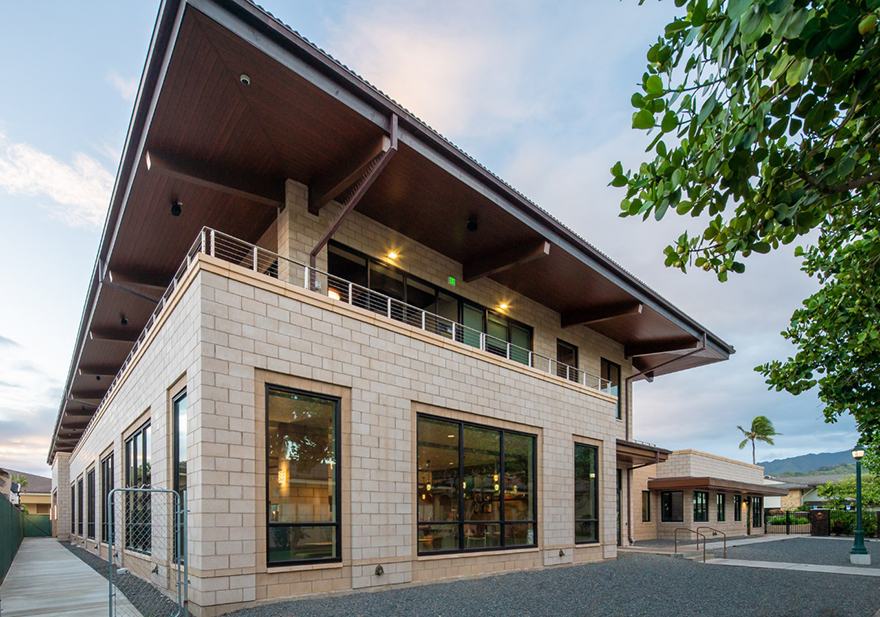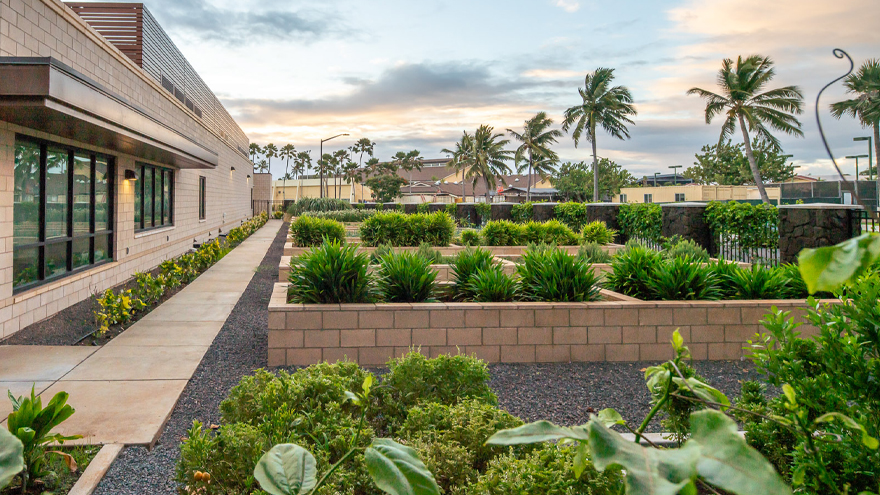
Image credit – CRSA | The Banyan Dining Hall | Custom Stainless Steel Railing by AGS Stainless Inc. To learn more about the Brigham Young University-Hawaii Cafeteria, visit the CRSA website or watch this video.
The Scenario |
BYU–Hawaii set a 5-year goal of growth and continued diversification of its student body by focusing on attracting students from smaller communities in the Pacific. Communities that ordinarily would not have had an opportunity to attend an educational facility like BYU-Hawaii. But, the college had already outgrown its existing dining facility. How would the college meet the food service needs of a projected student body of more than 3,000 from more than 70 countries? Build a new dining facility! Recently, AGS Stainless discussed BYU-Hawaii’s new dining hall, designed by CRSA Architects with a design team member, Rachael Bangerter, Interior Designer.
The Interview |
Interior Designer, Rachael Bangerter
Kevin: Rachel, it’s a pleasure to speak with you. I know you recently celebrated the grand opening of this gorgeous new dining facility.
As I reviewed the images, I couldn’t help but admire how aesthetically pleasing this new dining hall is. The textures you chose, the colors, and I especially loved the way you seamlessly unified the building’s interior and exterior by using the same custom stainless railing in both areas. Congratulations on a great project!
If I might ask, what were some of the considerations your team had in mind as you worked to bring this project to life?
Rachael: Well, Kevin, both the location and the climate were two key considerations. We really wanted to provide the right aesthetic. Being in a collegiate setting, with an anticipation of heavy student use, durability was very important. However, it wasn’t the only factor. In both the interior and the exterior of the facility, we really wanted to use products and materials that were highly durable – but that also brought tremendous visual impact to the project. It was important to us that the college had a facility that would hold up well and be one that they could feel good about over the long term. We really wanted to make sure the client had something that was going to withstand, you know, that environment. Those were a couple of the bigger factors.
Kevin: It’s great to hear a bit about your approach. So how long has the facility been open now?
Rachael: We had a grand opening in April (2022), and with three semesters under our belt, the dining hall is in full swing! And as you know, the college serves over 70 different cultures there on campus!
Kevin: Is it common for a college dining halls to offer such food diversity to their students? Actually, didn’t I read that they even grow some of their food on-site?
Rachael: BYU-Hawaii has a wide range of people who attend the campus. And so, the food services they offer their students must provide for a wide range of dietary needs and cultural differences. And yes, to meet those wide-ranging food diversity goals, they even grow some of their food on-site!

Image credit – CRSA |
The campus has undergone a lot of changes over the last five years. Increasing student diversity was actually one of the principal drivers behind building the new dining hall. For example, a lot of effort has gone into reaching more people, and especially those in some of the Pacific Islands. These are communities, and people, who wouldn’t previously have had an opportunity to study at an educational facility like this one. So with this growth, this diversity, the previous facility was just not large enough. You know, they had just outgrown it.
And, you know, when you see such a concept at work, when you see how the food is grown and nurtured; then you know, in that spirit of aloha feeling, that we were taking care of what we have, the island and the things entrusted to us.
And this new facility is not just about the students and the faculty. The new dining hall has been a welcome addition to the community. In that area of the island, there is limited development and few food services options. To address this, the college provides catering services and rental of the private dining area to the community. This means the community can use the facility for weddings and other events. So again, it’s a facility that is there to serve the entire community, not just the students and faculty.
Kevin: Rachel, it sounds like CRSA was able to design a dining hall that is more than just a place for the students and faculty to eat. Well done.
I’d like to transition back to the discussion of the larger project now. Can you speak more to the principles that guided you in the selection of the products and materials you used in the building?
Rachael: As I mentioned, with each of the products we selected, we really wanted to give the college something that’s going to have longevity, durability, and have beautiful aesthetics. A good example of this is the exposed ductwork. We wanted the facility to capture a little bit of an industrial feel but still keep it very open and welcoming to the students. The interplay between these elements was definitely a part of the design process.
When you step into the facility, you’re greeted by an immediate sense of openness. We also wanted the facility to reflect and complement the natural Hawaiian environment surrounding it. So indoors, you’ll find many of the same colors you find in the surrounding property. You’ll also find visual representations of volcanos, the sky, and the marine environment artfully captured. Outdoors, there is wayfinding to help you explore the property and stainless steel cable to minimize obstruction of the surrounding area as your peer through the railing on the upper floor. These are just a few examples of how we designed this new facility to help visitors feel connected to the surrounding environment; and our desire to keep things feeling, you know, open.
We also incorporated sustainability into the design. We chose products that come from companies that have sustainability as a part of their mindset, you know, their business model. This guided us in our decision-making process. An example is the carpet tiles and the railing. For the carpet tiles, we chose a company that has established sustainability and gives back as a corporate mandate. And being aware of the tremendous visual impact it adds to the property, and the fact that stainless steel is 100% recyclable, having AGS Stainless custom-design and then prefabricate the marine-grade stainless railing for the facility was the natural choice.
Where possible, we tried to include products that we could source locally. Being on an island, this wasn’t always easy to do, but this was something we really worked at. For example, we were able to choose lighting fixtures that were made by people locally. We were also able to incorporate some local fabrics for the booths and furniture. We were able to use real Koa wood as a feature wall in the private dining room and Koa laminate throughout the facility.
So, trying to really marry the architecture and the interior design to both the land and the people was definitely our goal.Kevin: Fantastic. Rachael, it was a real privilege for AGS Stainless to be a part of this project. Thank you for sharing some of the project highlights with us.
Rachael: You’re Welcome.
Project Details |
Project: BYU Banyan Café Location: Laie, Hawaii Architect: CRSA Architects Interior Design: CRSA Architects Contractor: DUCWORKS, Inc. Project Size: 42,146 sq.ft. Railing Products: AGS Stainless, Inc. | Rainier Cable Rail System with a flat stainless top rail. Total Project Cost: $33,500,000 Written by the: AGS Stainless Marketing Team
About BYU-Hawaii
BYU–Hawaii is an international center of learning in the Pacific. Its small campus is a unique laboratory of intercultural leadership development, where a diverse population of 3,200 students representing over 70 countries live, study and work together.
Why Choose AGS Stainless, Inc.|
For over 3-decades, AGS Stainless has fabricated custom railing systems for some of the world’s most distinctive homes, educational facilities, and commercial properties.
AGS offers custom-designed, offsite fabricated railing systems from high quality marine grade A316 stainless steel with stainless steel cable, stainless steel bar, wire mesh, or tempered glass panel infill options. An innovative component based design eliminates the need for any on site welding or cutting of posts and top rail.
For more information, visit AGSstainless.com or call 888-842-9492
.
